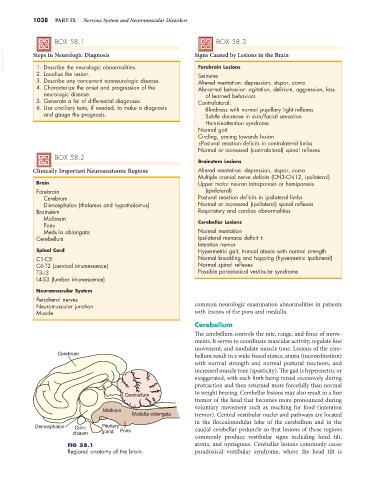Page 1066 - Small Animal Internal Medicine, 6th Edition
P. 1066
1038 PART IX Nervous System and Neuromuscular Disorders
BOX 58.1 BOX 58.3
VetBooks.ir Steps in Neurologic Diagnosis Signs Caused by Lesions in the Brain
1. Describe the neurologic abnormalities.
Forebrain Lesions
2. Localize the lesion. Seizures
3. Describe any concurrent nonneurologic disease. Altered mentation: depression, stupor, coma
4. Characterize the onset and progression of the Abnormal behavior: agitation, delirium, aggression, loss
neurologic disease. of learned behaviors
5. Generate a list of differential diagnoses. Contralateral:
6. Use ancillary tests, if needed, to make a diagnosis Blindness with normal pupillary light reflexes
and gauge the prognosis. Subtle decrease in skin/facial sensation
Hemi-inattention syndrome
Normal gait
Circling, pacing towards lesion
±Postural reaction deficits in contralateral limbs
Normal or increased (contralateral) spinal reflexes
BOX 58.2
Brainstem Lesions
Clinically Important Neuroanatomic Regions Altered mentation: depression, stupor, coma
Multiple cranial nerve deficits (CN3-CN12, ipsilateral)
Brain Upper motor neuron tetraparesis or hemiparesis
Forebrain (ipsilateral)
Cerebrum Postural reaction deficits in ipsilateral limbs
Diencephalon (thalamus and hypothalamus) Normal or increased (ipsilateral) spinal reflexes
Brainstem Respiratory and cardiac abnormalities
Midbrain
Pons Cerebellar Lesions
Medulla oblongata Normal mentation
Cerebellum Ipsilateral menace deficit ±
Intention tremor
Spinal Cord Hypermetric gait, truncal ataxia with normal strength
C1-C5 Normal knuckling and hopping (hypermetric ipsilateral)
C6-T2 (cervical intumescence) Normal spinal reflexes
T3-L3 Possible paradoxical vestibular syndrome
L4-S3 (lumbar intumescence)
Neuromuscular System
Peripheral nerves
Neuromuscular junction common neurologic examination abnormalities in patients
Muscle with lesions of the pons and medulla.
Cerebellum
The cerebellum controls the rate, range, and force of move-
ments. It serves to coordinate muscular activity, regulate fine
movement, and modulate muscle tone. Lesions of the cere-
Cerebrum bellum result in a wide-based stance, ataxia (incoordination)
with normal strength and normal postural reactions, and
increased muscle tone (spasticity). The gait is hypermetric or
exaggerated, with each limb being raised excessively during
protraction and then returned more forcefully than normal
Cerebellum to weight bearing. Cerebellar lesions may also result in a fine
tremor of the head that becomes more pronounced during
voluntary movement such as reaching for food (intention
Midbrain
Medulla oblongata tremor). Central vestibular nuclei and pathways are located
in the flocculonodular lobe of the cerebellum and in the
Diencephalon Optic Pituitary caudal cerebellar peduncle so that lesions of these regions
chiasm gland Pons
commonly produce vestibular signs including head tilt,
FIG 58.1 ataxia, and nystagmus. Cerebellar lesions commonly cause
Regional anatomy of the brain. paradoxical vestibular syndrome, where the head tilt is

